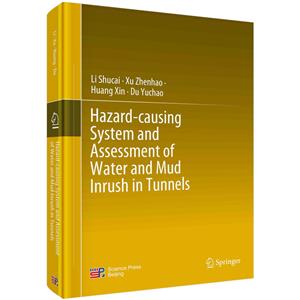Preface
Chapter 1 Introduction
1.1 Background and Significance of Research on Water and Mud Inrush in Tunnels
1.2 Water and Mud Inrush Hazard-causing System and Resistance Body
1.2.1 Water and mud inrush hazard-causing system
1.2.2 Resistance body
1.3 Research on the Hazard-causing System of Water and Mud Inrush in Tunnels
1.4 Summary of Research on Construction Risk Dynamic Evaluation of Tunnel Water and Mud Inrush
1.5 Summary of Research on Identification Methods of Tunnel Water and Mud Inrush Hazard-causing System
Chapter 2 Classification and Geological Identification of Water and Mud Inrush Hazard-causing Systems in Tunnels
2.1 Karst-category of Hazard-causing System
2.1.1 Corrosion fissure type
2.1.2 Karst cave type
2.1.3 Pipe and underground river type
2.2 Fault-category of Hazard-causing System
2.2.1 Water-enrich fault type
2.2.2 Water-conductive fault type
2.2.3 Water-resistant fault type
2.3 Other-categoryofHazard-causing System
2.3.1 Intrusive contact type
2.3.2 Structural fissure type
2.3.3 Unconformable contact type
2.3.4 Differential weathering type
2.3.5 Special condition type
2.4 Disaster-forming Pattern of Water and Mud Inrush Hazards in Tunnels
2.4.1 Directly revealed type of water and mud inrush
2.4.2 Progressive failure type of water and mud inrush
2.4.3 Seepage instability type of water and mud inrush
2.4.4 Intermittent failure type of water and mud inrush
2.5 Summary
Chapter 3 Typical Cases and Analysis of Water and Mud Inrush in Tunnels
3.1 Typical Cases of Water and Mud Inrush in Karst-category Hazard-causing System
3.1.1 Typical case of corrosion fissure type water and mud inrush--Qiyueshan Tunnel of Lichuan-Wanzhou Expressway
3.1.2 Typical case of karst cave type water and mud inrush--Daba Tunnel of Longshan-Yongshun Highway
3.1.3 Typical case of pipe and underground river type water and mud inrush--Qiyueshan Tunnel of Shanghai-Chengdu West Highway
3.2 Typical Cases of Water and Mud Inrush in Fault-category Hazard-causing System
3.2.1 Typical case of water-enrich fault type water and mud inrush--Baiyun Tunnel of Nanning-Guangzhou Railway
3.2.2 Typical case of water-conductive fault type water and mud inrush--Yonglian Tunnel of Jfan-Lianhua Expressway
3.2.3 Typical case of water-resistant fault type water and mud inrush--Qiyueshan Tunnel of Yichang-Wanzhou Railway
3.3 Typical Cases of Water and Mud Inrush in Other-category Hazard-causing System
3.3.1 Typical case of intrusive contact type water and mud inrush--Xiangyun Tunnel of Guangtong-Dali Railway
3.3.2 Typical cases of structural fissure type water and mud inrush
3.3.3 Typical case of unconformable contact type water and mud inrush--Changlashan Tunnel of Qinghai Provincial Highway
3.3.4 Typical case of differential weathering type water and mud inrush--Junchang Tunnel of Cenxi- Shuiwen Highway
3.3.5 Typical cases of special condition type water and mud inrush
3.4 Summary
Chapter 4 Tunnel Route Selection in Karst Region
4.1 Underground River System
4.1.1 Underground river system structural characteristics and its macro-geological identification
4.1.2 Engineering identification of underground river systems
4.1.3 The influence of the underground river system on tunnel route selection
4.1.4 Principles of tunnel route selection in the underground river system
4.2 Karst Spring System
4.2.1 Karst spring system structural characteristics and its macro-geological identification
4.2.2 Engineering identification ofkarst spring systems
4.2.3 The influence ofkarst spring systems on tunnel route selection
4.2.4 Principles of tunnel route selection in karst spring system
4.3 Dispersed Drainage Karst Water System
4.4 Evaluation of Karst Tunnel Route Selection
4.4.1 Evaluation model for karst tunnel route selection
4.4.2 Evaluation factors and weight analysis ofkarst tunnel route selection
4.4.3 The complete hierarchical order
4.4.4 Grading criteria
4.5 Engineering Application
4.5.1 Project overview
4.5.2 The development characteristics of underground rivers in the tunnel area
4.5.3 Engineering analogy
4.5.4 Tracer test
4.5.5 Geophysical prospecting and investigation inside the tunnel
4.5.6 Evaluation ofkarst tunnel route selection
4.6 Summary
Chapter 5 A Dynamic Interval Risk Assessment Method for Water and Mud Inrush during Tunnel Construction
5.1 Risk Assessment Conceptual Model and Index Rating
5.1.1 Hydrogeology and geological engineering conditions
5.1.2 Tunnel construction factors
5.1.3 Dynamic feedback of construction information
5.2 Fuzzy Evaluation of Water and Mud Inrush Interval Risk
5.2.1 Construction of interval risk calculation model
5.2.2 Interval risk membership calculation
5.2.3 Interval factor weight analysis
5.2.4 Relative dominance analysis of interval matrix
5.3 Tunnel Construction Permit Mechanism and Risk Management
5.3.1 Construction permit mechanism and risk management
5.3.2 Implementation procedures of the construction permit mechanism and risk management
5.3.3 Principle of construction permit mechanism
5.4 Case Study of the Qiyueshan Tunnel: Dynamic Evaluation and Control of Water and Mud Inrush Risk
5.4.1 Preliminary assessment
5.4.2 Secondary assessment
5.4.3 Dynamic assessment
5.5 Summary
Chapter 6 Assessment Method of the Resistance Body against Water and Mud Inrush in Tunnels
6.1 Influencing Factors of the Resistance Body Stability
6.1.1 Influencing factors of the disaster source
6.1.2 Influencing factors of the resistance body
6.2 Establishment of the Resistance Body Assessment Method
6.3 Grading and Scoring of Factors Affecting the Resistance Body Stability
6.3.1 Grading and scoring of factors affecting disaster source
6.3.2 Grading and scoring of factors affecting resistance body
6.4 Implementation Procedure of the Resistance Body Assessment
6.5 Engineering Verification
6.6 Summary
Chapter 7 Recognition Methods for Hazard-causing Systems of Water and Mud Inrush in Tunnels
7.1 Implementation of the Recognition Method for Water and Mud Inrush Hazard-causing System
7.1.1 Implementation process
7.1.2 Implementation principles
7.2 Typical Hazard-causing System Characteristics
7.2.1 Geological recognition
7.2.2 Geophysical prospecting recognition
7.2.3 Drilling recognition
7.3 Engineering Application
7.3.1 Project overview
7.3.2 Geological recognition
7.3.3 Geophysical recognition
7.4 Summary
Chapter 8 Dynamic Management and Analysis Platform for Tunnel Water and Mud Inrush Cases
8.1 Design Objectives and Requirements of the Case Management and Analysis Platform
8.1.1 Design objectives of the platform
8.1.2 General requirements for platform design
8.2 System Development Procedure
8.3 Platform Composition and Architecture
8.3.1 Platform composition
8.3.2 B/S architecture
8.4 Main Functions of the System
8.4.1 User authentication login
8.4.2 Case display, retrieval, and download
8.4.3 Case submission
8.4.4 Case review
8.4.5 Case comment
8.4.6 Case analysis
8.5 Summary
References
Appendix

















